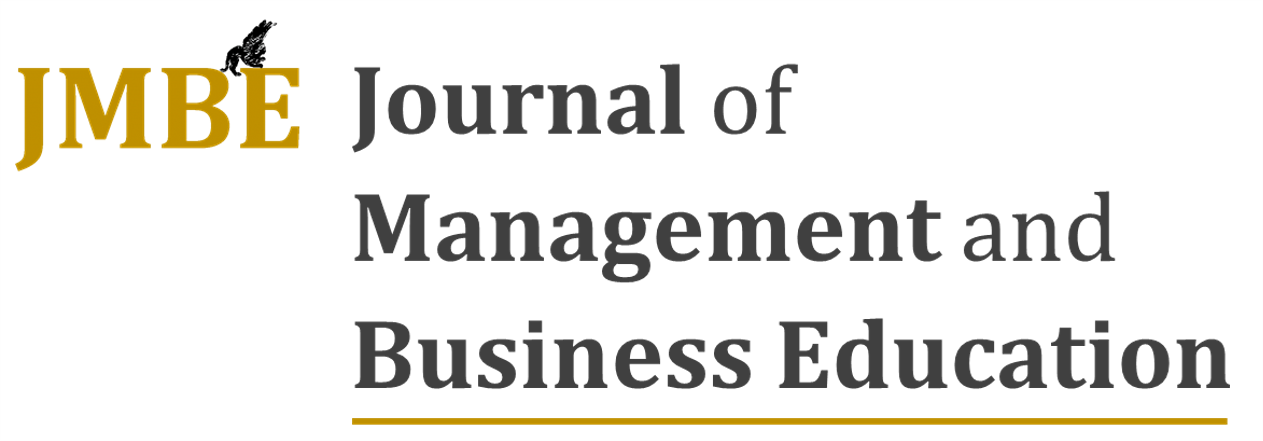The impact of collectivism orientation and gender identity on work-life balance and life satisfaction relationship: a UK – Spain comparison
DOI:
https://doi.org/10.35564/jmbe.2021.0004Keywords:
work-life balance, life satisfaction, influence of culture, gender identity, individual-level orientations of collectivismAbstract
Difficulties in balancing work and non-work roles have a negative impact on an individual’s life satisfaction. This study investigates the relationship between work-life balance and life satisfaction across the United Kingdom and Spain. It also explores the moderating effects of individual orientations of collectivism and gender identity. The used scales measured Work-life Balance (WLB), Life Satisfaction (LS), Collectivism vs. Individualism orientations, and Gender identity. Collectivism/Individualism was measured and analysed at individual-level rather than at cultural-level. Data was collected from 52 British and 69 Spanish full-time employed women through an online survey. Correlational analyses and hierarchical multiple regression were conducted. Findings indicated that work-life balance had positive effects on life satisfaction across two different cultures. Those effects were stronger for British than Spanish women. Moderating effects were not found. Although, work-life balance, collectivism individual-orientation, and feminine identity predicted life satisfaction in the UK and only work-life balance predicted life satisfaction in Spain. This study extends the literature on work-life balance and life satisfaction relationship and the influence of culture, whilst also contributing to the under-researched area of the influence of gender identity on that relationship. The results might contribute to developing better strategies for promoting work-life balance
Downloads
References
Allen, T. D., & Martin, A. (2017). The work-family interface: A retrospective look at 20 years of research in JOHP. Journal of Occupational Health Psychology, 22(3), 259. https://doi.org/10.1037/ocp0000065
Álvarez, B., & Miles, D. (2003). Gender effect on housework allocation: Evidence from Spanish two-earner couples. Journal of Population Economics, 16(2), 227-242. https://doi.org/10.1007/s001480200126
Aryee, S., Luk, V., Leung, A., & Lo, S. (1999). Role Stressors, Interrole Conflict, and Well- Being: The Moderating Influence of Spousal Support and Coping Behaviors among Employed Parents in Hong Kong. Journal of Vocational Behavior, 54(2), 259–278. https://doi.org/10.1006/jvbe.1998.1667
Atienza, F. L., Pons, D., Balaguer, I., & García-Merita, M. (2000). Propiedades psicométricas de la Escala de Satisfacción con la Vida en adolescentes. Psicothema, 12(2), 314-319. https://doi.org/10.11144/javerianacali.ppsi16-2.ppes
Aycan, Z. (2008). Cross-cultural approaches to work-family conflict. In Handbook of work-family integration (pp. 353-370). Academic Press. https://doi.org/10.1016/B978-012372574-5.50022-3
Bem, S. L. (1974). The measurement of psychological androgyny. Journal of Consulting and Clinical Psychology, 42(2), 155-162. https://doi.org/10.1037/h0036215
Bosques, L.E, Álvarez, G.L & Escoto, M.C (2015). Revisión de las propiedades psicométricas del inventario de roles sexuales de BEM. Enseñanza e Investigación en Psicología, 20(2), 119-129. https://www.redalyc.org/articulo.oa?id=29242799002
Brough, P., & Kalliath, T. (2009). Work-family balance: Theoretical and empirical advancements. Journal of Organizational Behavior, 30(5), 581-585. https://doi.org/10.1002/job.618
Brough, P., Timms, C., O'Driscoll, M. P., Kalliath, T., Siu, O. L., Sit, C., & Lo, D. (2014). Work-life balance: A longitudinal evaluation of a new measure across Australia and New Zealand workers. The International Journal of Human Resource Management, 25(19), 2724-2744. https://doi.org/10.1080/09585192.2014.899262
Bundgaard, K., & Brøgger, M. N. (2019). Who is the back translator? An integrative literature review of back translator descriptions in cross-cultural adaptation of research instruments. Perspectives, 27(6), 833-845. https://doi.org/10.1080/0907676X.2018.1544649
Carlson, D. S., & Kacmar, K. M. (2000). Work-family conflict in the organization: Do life role values make a difference? Journal of Management, 26(5), 1031-1054. https://doi.org/10.1177/014920630002600502
Díaz Rivera, P. E., Díaz Loving, R. & González Rivera, I. (2017). Validación de una escala breve de individualismo-colectivismo. Psicología Iberoamericana, 25(1), 30-40. https://www.redalyc.org/articulo.oa?id=133957571004
Diener, E., Emmons, R. A., Larsen, R. J., & Griffin, S. (1985). The satisfaction with life scale. Journal of Personality Assessment, 49(1), 71-75. https://doi.org/10.1207/s15327752jpa4901_13
Edwards, J. R., & Rothbard, N. P. (2000). Mechanisms linking work and family: Clarifying the relationship between work and family constructs. Academy of Management Review, 25(1), 178–199. https://doi.org/10.5465/amr.2000.2791609
Emslie, C., & Hunt, K. (2009). ‘Live to work’ or ‘work to live’? A qualitative study of gender and work-life balance among men and women in mid-life. Gender, Work & Organization, 16(1), 151-172. https://doi.org/10.1111/j.1468-0432.2008.00434.x
Frey B.S. (2018) What Makes People Happy?. In Economics of Happiness (p. 13-20). SpringerBriefs in Economics. Springer, Cham. https://doi.org/10.1007/978-3-319-75807-7_3
Galovan, A. M., Fackrell, T., Buswell, L., Jones, B. L., Hill, E. J., & Carroll, S. J. (2010). The work-family interface in the United States and Singapore: Conflict across cultures. Journal of Family Psychology, 24(5), 646-656. https://doi.org/10.1037/a0020832
Gelfand, M. J., Erez, M., & Aycan, Z. (2007). Cross-cultural organizational behavior. Annual Review of Psychology, 58, 479-514. https://doi.org/10.1146/annurev.psych.58.110405.085559
Greenhaus, J. H., & Allen, T. D. (2011). Work-family balance: A review and extension of the literature. In J. C. Quick & L. E. Tetrick (Ed.), Handbook of occupational health psychology (p. 165-183). American Psychological Association. https://doi.org/10.2307/j.ctv1chs29w.14
Greenhaus, J., Allen, T. & Spector, P. (2006), Health Consequences of Work-Family Conflict: The Dark Side of the Work-Family Interface. In Perrewé, P. & Ganster, D. (Ed.) Employee Health, Coping and Methodologies (p. 61-98). Emerald Group Publishing Limited. https://doi.org/10.1016/S1479-3555(05)05002-X
Gregory, A., & Milner, S. (2009). Work-life balance: A matter of choice? Gender, Work & Organization, 16(1), 1-13. http://dx.doi.org/10.1111/j.1468-0432.2008.00429.x
Haar, J. M. (2013). Testing a new measure of work-life balance: A study of parent and non-parent employees from New Zealand. The International Journal of Human Resource Management, 24(17), 3305-3324. https://doi.org/10.1080/09585192.2013.775175
Haar, J. M., Russo, M., Suñe, A., & Ollier-Malaterre, A. (2014). Outcomes of work-life balance on job satisfaction, life satisfaction and mental health: A study across seven cultures. Journal of Vocational Behavior, 85(3), 361-373. https://doi.org/10.1016/j.jvb.2014.08.010
Hall, D. T., Kossek, E. E., Briscoe, J. P., Pichler, S., & Lee, M. D. (2013). Nonwork orientations relative to career: A multidimensional measure. Journal of Vocational Behavior, 83(3), 539-550. https://doi.org/10.1016/j.jvb.2013.07.005
Hammer, L. B., Kossek, E. E., Anger, W. K., Bodner, T., & Zimmerman, K. L. (2011). Clarifying work-family intervention processes: The roles of work-family conflict and family-supportive supervisor behaviors. Journal of Applied Psychology, 96(1), 134-150. https://doi.org/10.1037/a0020927
Hofstede, G. (2011). Dimensionalizing cultures: The Hofstede model in context. Online readings in psychology and culture, 2(1). https://doi.org/10.9707/2307-0919.1014
Kalliath, T., & Brough, P. (2008). Work-life balance: A review of the meaning of the balance construct. Journal of Management & Organization, 14(3), 323-327. https://doi.org/10.1017/s1833367200003308
Keene, J. R., & Quadagno, J. (2004). Predictors of perceived work-family balance: Gender difference or gender similarity?. Sociological Perspectives, 47(1), 1-23. https://www.jstor.org/stable/10.1525/sop.2004.47.1.1
Kelan, E. (2009). Performing gender at work. Springer. DOI 10.1057/9780230244498
Kossek E.E., & Ollier-Malaterre A. (2013). Work-life policies: Linking national contexts, organizational practice and people for multi-level change. In Poelmans S., Greenhaus J.H., & Maestro M.L.H. (Eds), Expanding the boundaries of work-family research (pp. 3-31). Palgrave Macmillan. https://doi.org/10.1057/9781137006004_1
Kossek, E. E., Valcour, M., & Lirio, P. (2014). The sustainable workforce: Organizational strategies for promoting work-life balance and wellbeing. Wellbeing: A Complete Reference Guide, 1-24. https://doi.org/10.1002/9781118539415.wbwell030
Lamm, E., & Meeks, M. D. (2009). Workplace fun: the moderating effects of generational differences. Employee Relations, 31(6), 613-631. https://doi.org/10.1108/01425450910991767
Lippa, R. A. (2005). Gender, nature, and nurture. New York: Routledge. https://doi.org/10.4324/9781410612946
Lu, L., Cooper, C. L., Kao, S. F., Chang, T. T., Allen, T. D., Lapierre, L. M., ... & Spector, P. E. (2010). Cross-cultural differences on work-to-family conflict and role satisfaction: A Taiwanese-British comparison. Human Resource Management, 49(1), 67-85. https://doi.org/10.1002/hrm.20334
Lunau, T., Bambra, C., Eikemo, T. A., Van Der Wel, K. A., & Dragano, N. (2014). A balancing act? Work-life balance, health and well-being in European welfare states. The European Journal of Public Health, 24(3), 422-427. https://doi.org/10.1093/eurpub/cku010
Lyness, K. S., & Judiesch, M. K. (2014). Gender egalitarianism and work-life balance for managers: Multisource perspectives in 36 countries. Applied Psychology, 63(1), 96-129. https://doi.org/10.1111/apps.12011
Martens, E., Pestman, W., de Boer, A., Belitser, S., & Klungel, O. (2006). Instrumental variables: Application and limitations. Epidemiology, 17(3), 260-267. https://doi.org/10.1097/01.ede.0000215160.88317.cb
McDowell, L. (1999). Gender, identity and place: Understanding feminist geographies. Cambridge: Polity Press. https://doi.org/10.15299/local.2015.11.5.181
McGinnity, F., & Calvert, E. (2009). Work-life conflict and social inequality in Western Europe. Social Indicators Research, 93(3), 489-508. https://doi.org/10.1007/s11205-008-9433-2
Mescher, S., Benschop, Y., & Doorewaard, H. (2010). Representations of work—life balance support. Human Relations, 63(1), 21-39. https://doi.org/10.1177/0018726709349197
Nadal, K. L. (2017). Neurosexism. In Nadal, K. L. (Ed.), The SAGE encyclopedia of psychology and gender (pp. 1243-1246). SAGE Publications. http://dx.doi.org/10.4135/9781483384269
Noda, H. (2019). Work-Life Balance and Life Satisfaction in OECD Countries: A Cross-Sectional Analysis. Journal of Happiness Studies, 1325-1348. https://doi.org/10.1007/s10902-019-00131-9
Ollier-Malaterre, A. (2016). Cross-national work-life research: A review at the individual level. In Allen, T. & Eby, L. (Ed.), Oxford handbook of work and family (p. 315-332). New York: Oxford University Press. https://doi.org/10.1093/oxfordhb/9780199337538.013.18
Ozolins, U. (2009). Back translation as a means of giving translators a voice. Translation & Interpreting, 1(2), 1-13. http://trans-int.org/index.php/transint/article/view/38
Powell, G. N., & Greenhaus, J. H. (2010). Sex, gender, and decisions at the family→ work interface. Journal of Management, 36(4), 1011-1039. https://doi.org/10.1177/0149206309350774
Roberts, K. (2007). Work-life balance–the sources of the contemporary problem and the probable outcomes: A review and interpretation of the evidence. Employee Relations, 29(4), 334-351. https://doi.org/10.1108/01425450710759181
Scherer, S., & Steiber, N. (2007). Work and family in conflict? The impact of work demands on family life. In Gallie, D. (Ed.), Employment regimes and the quality of work (p. 137-178). Oxford: Oxford University Press. https://doi.org/10.1093/acprof:oso/9780199230105.003.0005
Spector, P. E., Allen, T. D., Poelmans, S. A., Lapierre, L. M., Cooper, C. L., O'Driscoll, M. P., Sanchez, J. I., Abarca, N., Alexandrova, M., Beham, B., Brough, P., Ferreiro, P., Fraile, G., Lu, C., Lu, L., Moreno-Velazquez, I., Pagon, M., Pitariu, H., Salamatov, V., Shima, S., Simoni, A. S., Siu, O. L. & Widerszal-Bazyl, M. (2007). Cross-national differences in relationships of work demands, job satisfaction, and turnover intentions with work-family conflict. Personnel Psychology, 60(4), 805-835. https://doi.org/10.1111/j.1744-6570.2007.00092.x
Stratton, L. S. (2003). Gains from trade and specialization: The division of work in married couple households. In Moe, K. S. (Ed.), Women, Family, and Work (p. 65-82). Blackwell Publishing Ltd https://doi.org/10.1002/9780470755648.ch5
Tabachnick, B. G., & Fidell, L. S. (2001). Using Multivariate Statistics (4th Ed.). Boston: Allyn and Bacon. ISBN 0-321-05677-9
Triandis, H. C. & Gelfland, M. J. (1998). Converging measurement of horizontal and vertical individualism and collectivism. Journal of Personality and Social Psychology, 74(1), 118-128. https://doi.org/10.1037/0022-3514.74.1.118
Valcour, M. (2007). Work-based resources as moderators of the relationship between work hours and satisfaction with work-family balance. Journal of applied psychology, 92(6), 1512-1523. https://doi.org/10.1037/0021-9010.92.6.1512
Van Steenbergen, E. F., & Ellemers, N. (2009). Is managing the work-family interface worthwhile? Benefits for employee health and performance. Journal of Organizational Behavior, 30(5), 617-642. https://doi.org/10.1002/job.569
Downloads
Published
How to Cite
Issue
Section
License
Copyright (c) 2023 Journal of Management and Business Education

This work is licensed under a Creative Commons Attribution-NonCommercial-ShareAlike 4.0 International License.
License terms at: https://creativecommons.org/licenses/by-nc/4.0/legalcode




